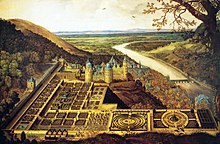List of Counts Palatine of the Rhine
The list of rulers of the Electoral Palatinate contains all the counts palatine of the Rhine who ruled in the later Electoral Palatinate and all holders of the associated Palatine electoral dignity. Not listed are dukes of Bavaria who held the title of count palatine but did not rule in the Palatinate, as well as ruling members of Palatine collateral lines who did not hold the electoral dignity.
The line of the Palgraves of the Rhine begins in 1085 after the death of the last Palgrave of Lorraine from the House of the Ezzones, Hermann II, whose widow Adelheid married Heinrich von Laach in her third marriage. Emperor Henry IV rewarded him for his loyalty in the investiture dispute with the Palatine dignity and appointed him imperial administrator during his campaign in Italy in 1090. With Heinrich von Laach, whose hereditary estates lay on both sides of the Rhine in the Mayengau and Engersgau, the office of Count Palatine shifted from the territory of the Lorraine (Ruhrgau and Brabant) to the south, which is why Heinrich was the first to call himself "Count Palatine on the Rhine".
He was succeeded by his stepson and adopted son Siegfried of Ballenstedt from the House of Ascanians, who built Cochem Castle on the Moselle and died in 1113 in battle against Emperor Henry V. The emperor did not recognize the inheritance claims of Siegfried's underage son and instead appointed his loyalist Gottfried of Calw as Count Palatine of the Rhineland. Siegfried's widow Gertrud of Northeim († 1154) married Otto I of Salm-Rheineck, who helped his stepson Wilhelm of Ballenstedt to be reinstated as Count Palatine in 1126, albeit still under Gottfried's regency until he came of age; Gertrud's brother-in-law, Lothar III of Supplinburg, had helped after he had been elected Roman-German king in 1125. Wilhelm died childless in 1140 and left his own property to a monastery. (Freely hereditary estates of the respective counts palatine, estates held as fiefs and palatine official estates were basically distinguished. However, personal property could be given in fief to the archbishops or feudal property that had fallen to the empire could be added to the official property by the king). However, the first Hohenstaufen king, Konrad III, who reigned in the meantime, did not recognize Otto's titular claims, who had been appointed Co-Palatine Count by Emperor Lothar, and instead enfeoffed his own half-brother Heinrich Jasomirgott of Austria and, a year later, his brother-in-law Hermann von Stahleck with the Palatine Count's office, who, in contrast to his predecessors, was already wealthy on the Middle Rhine.
Since then, his Stahleck Castle near Bacharach was the seat of the Palatine counts. After Hermann's death in 1156, Emperor Frederick I Barbarossa transferred the Palatine dignity to his half-brother Conrad the Hohenstaufen, who also received the Hohenstaufen family property in the Speyergau and Wormsgau (with the Worms High Collegiate Bailiwick) as well as the bailiwick of the Schönau Monastery near Heidelberg. Thus the focus of the Palatine counts again shifted further south along the Rhine. Around 1182 Konrad moved his court from Stahleck to Heidelberg Castle. After his death, the Palatinate fell to his son-in-law, Guelph Henry V of Brunswick and his wife Agnes of Staufen in 1195. Their only son Heinrich died childless in 1214, after their daughter Agnes of Brunswick had been betrothed to the six-year-old Wittelsbach Otto II of Bavaria in 1212. The latter's powerful father, Louis the Kelheim, had initially supported the Guelph Emperor Otto IV, the brother of Count Palatine Henry V, for which he received confirmation of the hereditary status of the Duchy of Bavaria, but in 1212 he had switched to the side of Otto's young counter-king, the Hohenstaufen Frederick II, who in return enfeoffed him with the Palatinate. The three Rhenish archbishops then ousted the Guelph Henry V from the territories on the Rhine. Ludwig the Kelheim thus laid the foundation for the Wittelsbach rule in Bavaria, which lasted until 1918, as well as for the equally long-lasting rule of his house in the Palatinate. All later Palatine counts and thus also the Electors of the Palatinate came from the House of Wittelsbach.
Since the existence of the Electoral College (around the middle of the 13th century), the Palatinate (with an interruption from 1623 to 1648) was also an electorate - the respective Palatine thus had the right to participate in the election of the Roman-German king. This affiliation was codified in 1356 by the Golden Bull issued by Emperor Charles IV. Since then, the territories of the Wittelsbach counts palatine on the Rhine, which had accumulated in the meantime, were known as the Electoral Palatinate. With the beginning of the Thirty Years' War, which the Calvinist Palatine Elector Frederick V had triggered by accepting his election as Bohemian "Winter King" in the anti-Habsburg Estates Revolt of 1619/20, the electoral dignity was lost to the Catholic line of the Dukes of Bavaria in 1623. After the Peace of Westphalia in 1648, an eighth Kur was established for the Palatinate (causa palatina), which again coincided with the old Kur when the Bavarian Wittelsbach dynasty died out in 1777. Since 1720, the Electoral Palatinate residence had been moved from Heidelberg to Mannheim Castle, and in 1778 the seat of power of Palatinate-Bavaria was transferred from Mannheim to the Munich residence.

Heidelberg Castle (1620), residence of the Palatinate and Electorate since 1182

Stahleck Castle on the Middle Rhine, headquarters of the Palatine Counts from 1142 to 1182

Cochem Castle on the Moselle
Search within the encyclopedia